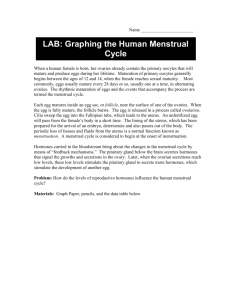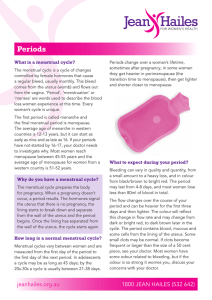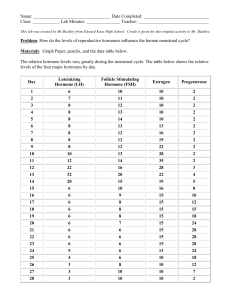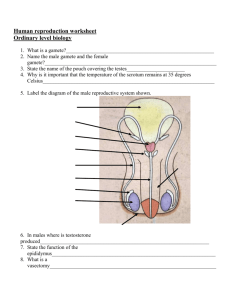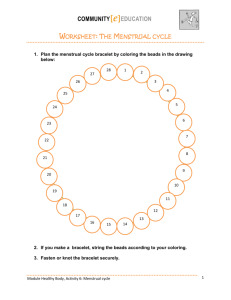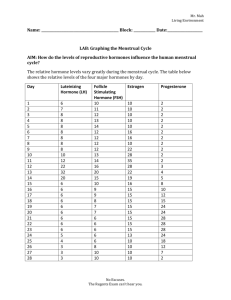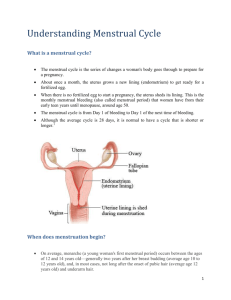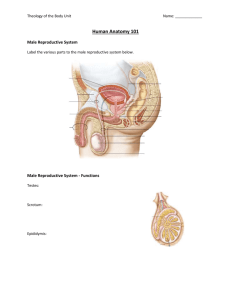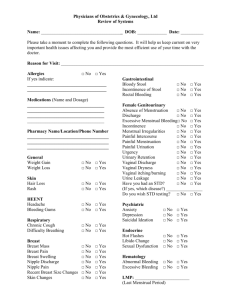Your Period
advertisement
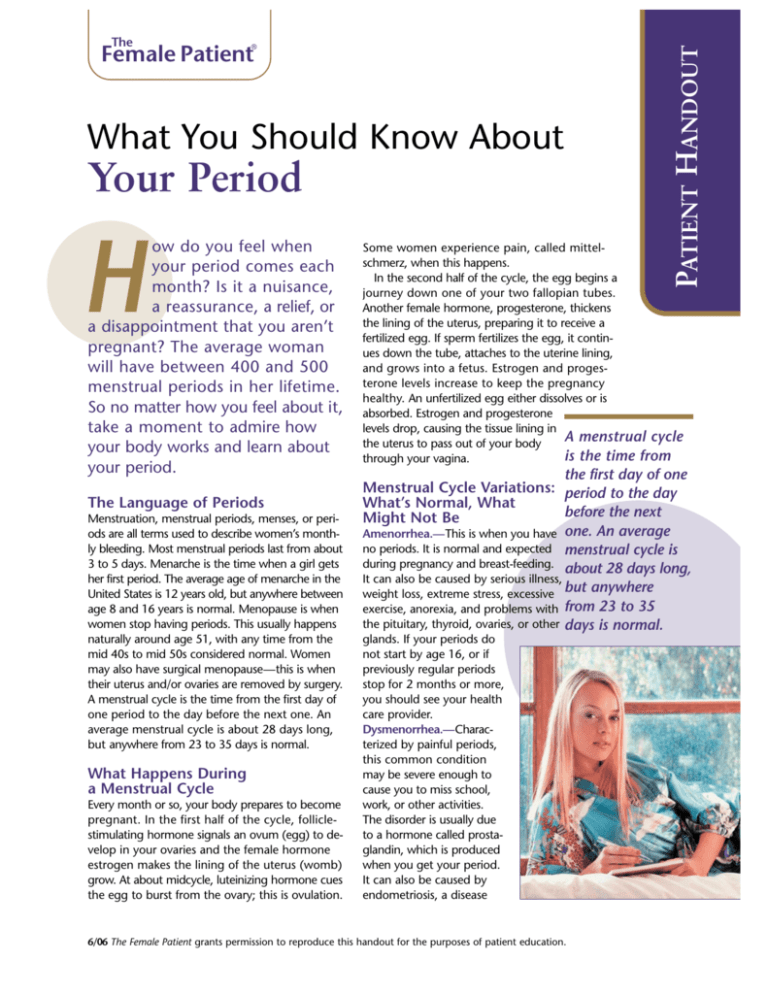
® What You Should Know About Your Period H ow do you feel when your period comes each month? Is it a nuisance, a reassurance, a relief, or a disappointment that you aren’t pregnant? The average woman will have between 400 and 500 menstrual periods in her lifetime. So no matter how you feel about it, take a moment to admire how your body works and learn about your period. The Language of Periods Menstruation, menstrual periods, menses, or periods are all terms used to describe women’s monthly bleeding. Most menstrual periods last from about 3 to 5 days. Menarche is the time when a girl gets her first period. The average age of menarche in the United States is 12 years old, but anywhere between age 8 and 16 years is normal. Menopause is when women stop having periods. This usually happens naturally around age 51, with any time from the mid 40s to mid 50s considered normal. Women may also have surgical menopause—this is when their uterus and/or ovaries are removed by surgery. A menstrual cycle is the time from the first day of one period to the day before the next one. An average menstrual cycle is about 28 days long, but anywhere from 23 to 35 days is normal. What Happens During a Menstrual Cycle Every month or so, your body prepares to become pregnant. In the first half of the cycle, folliclestimulating hormone signals an ovum (egg) to develop in your ovaries and the female hormone estrogen makes the lining of the uterus (womb) grow. At about midcycle, luteinizing hormone cues the egg to burst from the ovary; this is ovulation. PATIENT HANDOUT The Female Patient Some women experience pain, called mittelschmerz, when this happens. In the second half of the cycle, the egg begins a journey down one of your two fallopian tubes. Another female hormone, progesterone, thickens the lining of the uterus, preparing it to receive a fertilized egg. If sperm fertilizes the egg, it continues down the tube, attaches to the uterine lining, and grows into a fetus. Estrogen and progesterone levels increase to keep the pregnancy healthy. An unfertilized egg either dissolves or is absorbed. Estrogen and progesterone levels drop, causing the tissue lining in A menstrual cycle the uterus to pass out of your body is the time from through your vagina. the first day of one Menstrual Cycle Variations: period to the day What’s Normal, What before the next Might Not Be Amenorrhea.—This is when you have one. An average no periods. It is normal and expected menstrual cycle is during pregnancy and breast-feeding. about 28 days long, It can also be caused by serious illness, weight loss, extreme stress, excessive but anywhere exercise, anorexia, and problems with from 23 to 35 the pituitary, thyroid, ovaries, or other days is normal. glands. If your periods do not start by age 16, or if previously regular periods stop for 2 months or more, you should see your health care provider. Dysmenorrhea.—Characterized by painful periods, this common condition may be severe enough to cause you to miss school, work, or other activities. The disorder is usually due to a hormone called prostaglandin, which is produced when you get your period. It can also be caused by endometriosis, a disease 6/06 The Female Patient grants permission to reproduce this handout for the purposes of patient education. Your Period that occurs when uterine-lining tissue grows on other pelvic organs. Nonprescription medications like aspirin, ibuprofen, and naproxen lower prostaglandin levels and often relieve the pain. These medications work best when taken as soon as your period starts, or even the day before. Dysmenorrhea that interferes with your life and cannot be controlled by medication may be treated in other ways. Menorrhagia.—This is when you have very heavy and long periods. The condition is common for a few years after menarche and a few years before menopause. An Even if your periods occasional heavy or prolonged period is not unusual if your are “normal” but pattern then returns to you want the normal. For excessive bleeding (e.g., soaking a pad or convenience of fewer, tampon every hour for 24 lighter, or no periods hours or more, or bleeding at all, you have the for 10 days or longer) you option of using should see your health care provider. Fibroids (noncancerhormonal birth ous growths in the uterus), endocontrol methods. metriosis, or an undetected pregnancy are some conditions that can cause menorrhagia. Very Frequent Periods.—Routinely having periods more often than every 3 weeks—counted from the first day of one period to the day before the next one, not from the end of one period to the beginning of the next—may not signal a problem. However, it is a good idea to get checked, as you may become anemic (have a low blood count) from such frequent bleeding. You may also want to discuss options for lengthening your cycles. Oligomenorrhea.—This describes very light or infrequent periods. Stress, travel, or just life may cause an occasional missed period. Regularly going for months without a period, or always having periods that don’t even require sanitary protection, may be signs of polycystic ovary syndrome (PCOS) or other hormonal problems. Resources • The National Women’s Health Information Center http://4women.gov/faq/menstru.htm 1-800-994-9662 Bleeding Between Periods.—Some women notice a few drops of vaginal bleeding or spotting around the time they ovulate. Heavy bleeding or many days of spotting between periods may indicate infection, noncancerous growths called polyps, or other conditions. If you fall into this category, you should get checked by your health care provider. Treating Period Problems The treatment of problems related to your period depends on the cause. Your health care provider will most likely give you a pregnancy test and perform a physical exam, which may include a pelvic exam, Papanicolaou (Pap) smear, blood tests, infection check, and/or perform an ultrasound. Don’t be surprised if your health care provider suggests using hormonal birth control methods—oral contraceptives, the patch, vaginal ring, birth control injection, or a hormone-containing intrauterine device (IUD)— as treatment, even if you’re not having sex, or have a female sexual partner. These methods can control heavy bleeding, cramping, and toofrequent periods and may be part of the treatment for PCOS and other hormonal problems. Even if your periods are “normal” but you want the convenience of fewer, lighter, or no periods at all, you have the option of using hormonal birth control methods. Research has shown it is safe to do so. Smokers over age 35 years, or women who have had a stroke, heart attack, or blood clot cannot use methods containing a combination of the two hormones estrogen and progesterone, but can usually use the hormone-containing IUD or the birth control injection since both contain progesterone only. In Conclusion Whether welcome or inconvenient, menstruation is part of women’s lives. Menstrual cycles vary from woman to woman, and at different times in each woman’s life. If you have questions about whether your pattern is normal, you should discuss them with your health care provider. This Patient Handout was prepared by Diane E. Judge, APN/CNP, using materials from The National Women’s Health Information Center; and Judge, DE, What You Should Know About Extended Cycle Contraception. The Female Patient. 2006;31(2):49-50. The Female Patient grants permission to reproduce this handout for the purposes of patient education. 6/06
